Daily Business Report-Nov. 12, 2014
New commuter terminal facade mural by Jari ‘Werc’ Alvarez commemorates the golden age of aviation and includes many symbols, including the huge letters, SAN, the airport’s designation. Future murals selected will be on display for three to five years.
Public Gets to Influence Future Art
At San Diego International Airport
San Diego International Airport will host a community forum and teen workshop to generate ideas on two future public art mural designs. The murals will be displayed on the east-facing Commuter Terminal wall. Attendees will have the chance to give feedback directly to the artist.
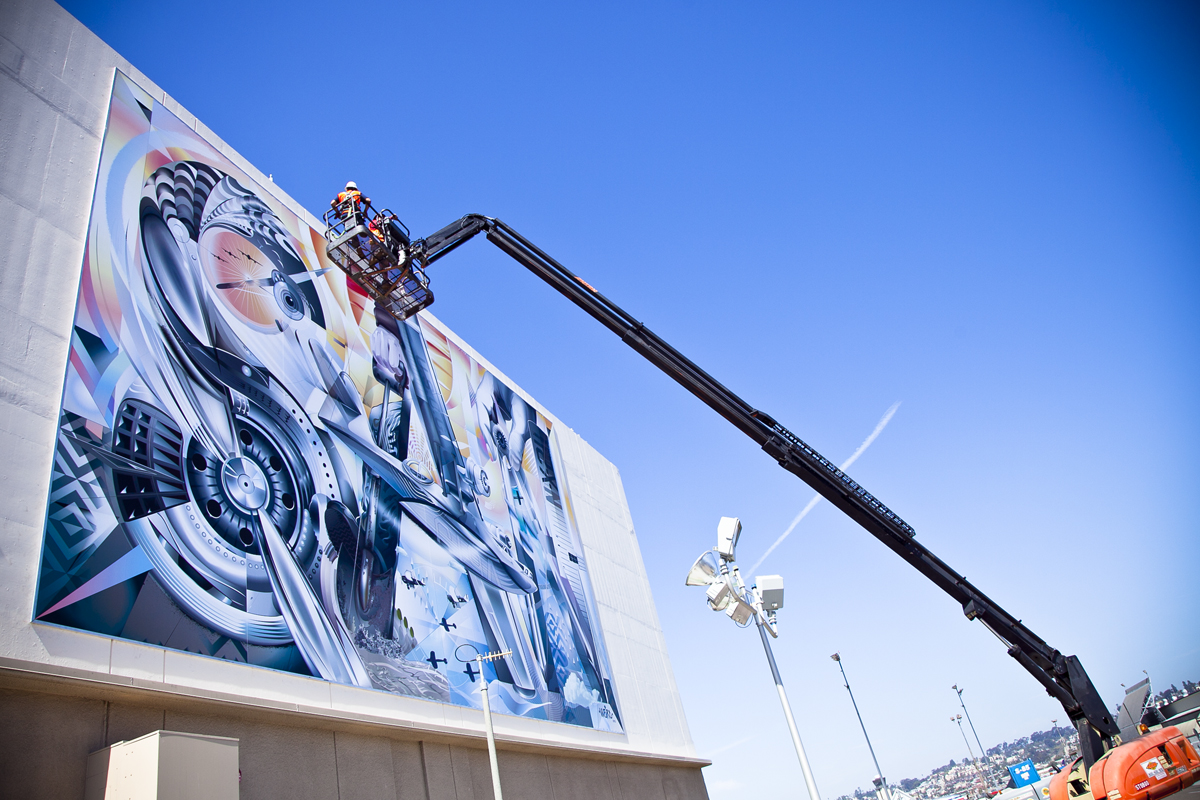
The community forum will be Nov. 14 from 9 to 10 a.m. in the third floor board room of the Commuter Terminal.
The teen workshop will be Nov. 15 from 2 to 5 p.m. in the Facilities Management Building at 2415 Winship Lane. The teen workshop is organized in collaboration with the Museum of Contemporary Art San Diego’s Teen Advisory Group (TAG), which is comprised of 15 teenagers from across San Diego County. TAG participants will create a small collaborative mural during the workshop, which will later be installed on the Youth Art Wall in Terminal 2 East.
In September 2013, Jari “Werc” Alvarez was awarded a contract to develop three unique artwork designs for the Commuter Terminal east-facing exterior wall. Each design will be on display for three to five years. Werc’s first design, “SAN,” was installed in March. As this wall is highly-visible to San Diego’s residents and visitors, the airport is seeking to engage the community in the development of Werc’s subsequent mural designs.
Two San Diego Universities
Among Top 50 for Veterans
San Diego is not only a major military complex, but an emerging military education center, with two local universities ranked among the top 50 for veterans.
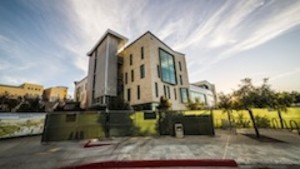
The Military Times newspaper ranked Cal State San Marcos the 20th and San Diego State University 38th among all universities nationally for veterans.
According to the newspaper, there were 439 veterans enrolled at Cal State San Marcos, almost 4 percent of total enrollment, and 1,041 at San Diego State, a smaller percentage of that much larger school.
“We are honored and proud to be recognized for our commitment and support of our veterans,” said Joan Putnam, director of the Joan and Art Barron Veterans Center at SDSU. “Being ranked among the top 50 best colleges for vets will help spread the word nationally that SDSU offers a high-quality education while providing excellent support services to student veterans.”
Cal State San Marcos recently opened a new veterans center to support the growing number of veterans at the campus.
Walmart Honored
Walmart, meanwhile, was honored by the San Diego Veterans Museum for hiring veterans, supporting active-duty soldiers and assisting local veterans programs. The company received the museum’s Corporation of the Year award at a luncheon at the Scottish Rite Center.
Last year, Walmart committed to priority hiring of any honorably discharged veteran within his or her first 12 months off active duty. Since that time, more than 67,861 veterans have been hired nationally, including more than 2,800 veterans in California.
— Times of San Diego

Home Sales Dip to Three-Year Low
Southern California homes sold at the slowest pace for the month of October in three years as sales to investors and cash buyers continued to run well below October 2013 levels, CoreLogic DataQuick reported today.
Additionally, the median price paid for a home fell month-over-month again and the single-digit gain from a year earlier was the smallest in 28 months.
A total of 19,271 new and resale houses and condos sold in Los Angeles, Riverside, San Diego, Ventura, San Bernardino and Orange counties in October. That was down 0.4 percent from 19,348 sales in September, and down 4.4 percent from 20,150 sales in October 2013, according to CoreLogic DataQuick.
______________________________________________________
San Diego County
Home sales in San Diego County in October totaled 3,308, a decline of 5.7 percent from sales of 3,509 in October 2013.
The median sale price in San Diego County was $440,000 for October, an increase of 6.6 percent from the median of $412,750 in October 2013
______________________________________________________
Last month’s Southland sales decline from September was not unusual. On average, Southern California sales have fallen 0.3 percent between September and October since 1988, when CoreLogic DataQuick data begin. October home sales have ranged from a low of 12,913 in 2007 to a high of 37,642 in 2003. October 2014 sales were 17.7 percent below the October average of 23,413 sales.
“It was another sub-par month for Southern California home sales,” said Andrew LePage, data analyst for CoreLogic DataQuick. “We’ve yet to see traditional buyers fill the void left by the drop-off in investor and cash buyers, which began in spring last year.
“Of course, there are multiple reasons for this year’s lackluster sales. New-home transactions are still running at about half their normal level. The resale market is hampered by constrained inventory in many areas, in part because some people who want to put their homes up for sale still haven’t regained enough equity to purchase their next home. Then there are the would-be buyers who continue to struggle with affordability and mortgage availability, if not uncertainty over their employment or the direction of the housing market.”
The median price paid for all new and resale houses and condos sold in the six-county region in October 2014 was $410,000, down 0.7 percent from $413,000 in September and up 6.8 percent from $383,750 in October 2013. The median price also fell month-over-month between September and August this year. The August median of $420,000 was the highest for any month since December 2007, when it was $425,000.
Distressed Sales Decline
Also in the region, distressed property sales continued to wane last month.

Foreclosure resales represented 4.8 percent of the Southern California resale market in October. That was up insignificantly from 4.7 percent the prior month and down from 6.3 percent a year earlier. In recent months the foreclosure resale rate has been the lowest since early 2007. In the current cycle, foreclosure resales hit a high of 56.7 percent in February 2009. Foreclosure resales are homes foreclosed on in the prior 12 months.
Short sales made up an estimated 5.9 percent of resales last month. That was down from 6.1 percent the prior month and down from 10.8 percent a year earlier. Short sales are transactions where the sale price fell short of what was owed on the property.
Other Southern California housing market highlights from October 2014:
• Absentee buyers — mostly investors and some second-home purchasers – bought 23.6 percent of the homes sold last month. That tied the September 2014 revised absentee level as the lowest since October 2010, when 22.1 percent of homes were sold to absentee buyers. The October figure was down from 27.1 percent a year earlier. The peak absentee share was 32.4 percent in January 2013, while the monthly average since 2000, when the CoreLogic DataQuick absentee data begin, is about 19 percent.
• Buyers paying cash accounted for 23.5 percent of October home sales, down from a revised 24.2 percent the prior month and down from 28.6 percent a year earlier. Last month’s figure was the lowest since January 2009, when 22.0 percent of homes were bought with cash. The peak was 36.9 percent in February 2013, and since 1988 the monthly average has been 16.7 percent.
• In October, Southern California home buyers committed a total of $4.12 billion of their own money in the form of down payments or cash purchases. That was down from a revised $4.50 billion in September. The out-of-pocket total peaked in May 2013 at $5.41 billion.
• In October, 12.9 percent of home purchase loans were adjustable-rate mortgages (ARMs), down slightly from 13.3 percent the month before and up from 12.0 percent a year earlier. The ARM share dropped to as low as 1.9 percent of home purchase loans in May 2009. Since 2000, a monthly average of about 30 percent of purchase loans have been ARMs.
• The typical monthly mortgage payment in Southern California was $1,574 in October 2014, down from $1,608 the month before and up from $1,499 a year earlier. Adjusted for inflation, the typical payment in October was 35.5 percent below the typical payment in the spring of 1989, the peak of the prior real estate cycle.
San Diego Region Attracts More Than
$15 Million for Various Water Projects
The San Diego region has been awarded more than $15 million in fast-tracked funding by the state Department of Water Resources for a variety of projects aimed at increasing local water supplies and decreasing demands, the San Diego County Water Authority reported Monday.
Together, the projects will produce or save more than 12,000 acre-feet of water annually, enough to serve nearly 25,000 typical four-person homes.
The state grant from voter-approved Proposition 84 (2006) provides funds for projects identified in the 2013 San Diego Integrated Regional Water Management Plan, which was developed collaboratively by a group comprising staff from the City of San Diego, the County of San Diego and the San Diego County Water Authority, along with an array of regional stakeholders.
The selected local projects will expand groundwater desalination and water recycling, improve water quality, and enhance water conservation initiatives such as the regional WaterSmart Turf Replacement Program. Work on six of the seven funded projects is expected to begin within the next several months. In the current round of projects, all $15,074,938 is going to the Water Authority or its member agencies — Carlsbad Municipal Water District, Fallbrook Public Utility District, Rincon del Diablo Municipal Water District, the City of San Diego and Sweetwater Authority.
Council Gives Final Approval
To Linkage Fee Compromise
The San Diego City Council gave final approval Monday to a compromise plan for a fee increase on commercial construction to fund the city’s affordable housing projects. The deal, approved on an 8-1 vote, ends a struggle between housing advocates and business leaders over the future of the fee, which was instituted in 1990. Six years later, the levy was halved as an economic stimulus.
Last year, the City Council approved restoring the charge to its original level — but as the city’s Independent Budget Analyst pointed out, the hike would have ranged from over 300 percent to more than 700 percent on certain types of building projects.
Opponents collected enough petition signatures to get the council to rescind the increase, which led to the compromise.
Provisions include returning the fee — which is calculated based on a project’s size and scope — to its 1990 level, phased in over three years beginning on Jan. 1; exempting developers of manufacturing, warehouse and nonprofit hospital projects from paying the fee as an economic development incentive; and maintaining current fee levels for research and development construction for the same reason.
— City News Service
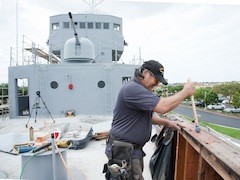
‘USS Neversail’ Getting Shipshape
The USS Recruit, the Navy ship that has never sailed, is getting a refurbishment from volunteers from the Corky McMillin Companies and the USS Midway Museum. They celebrated Veterans Day on Tuesday by starting a refurbishment project on the stuck-in-place ship.
Affectionately known as the “USS Neversail,” the vessel was built in 1949 as a mock training vessel for sailor recruits at the former Naval Training Center (NTC). The “throwback” buffet lunch was hosted by the Courtyard Marriot Liberty Station and featured moments of history, such as the recruits’ favorite dessert — pineapple upside down cake. Reconditioning of the ship kicked off in the morning, followed by lunch for 45 active duty volunteers, and continued ship reconditioning.
Reconditioning involves: cleaning and painting the outer aluminum skin,
restoration of the deck guns (real historic guns from the era), replacing the netting and replacing decorative emblems from the era.
Cumming Opens New Dubai Office
DUBAI, United Arab Emirates — San Diego-based Cumming, an international project management and consulting firm, has officially expanded its international operations by opening a new office in Dubai. The office replaces the smaller Dubai space Cumming previously occupied in Emaar Square. The new Dubai space gives increased capacity for the company, which is currently experiencing regional year-over-year growth of more than 50 percent, according to Finlay Cumming, the founder and CEO.
Cumming’s Dubai-based team specializes in program, project, construction, and cost management services. Cumming has more than 50 permanent team members working within the region.
Rudolph and Sletten Awarded Contract
For Math, Science, Engineering Building
Rudolph and Sletten has been awarded a contract for the new Math, Science and Engineering Building at Southwestern College in Chula Vista. Now in the schematic design phase, the two-story, 103,000-square-foot building has a budget of $60 million and will include 21 classrooms and 16 labs for physical and life science and math programs, as well as administrative space, faculty offices and meeting rooms.
The building will go in the area now home to the swimming pools, gym, racquetball courts and athletic department offices, currently known as the 1000 Building Complex. Rudolph and Sletten will be responsible for demolition as well as construction of the new building.
Construction is set to start in June 2016, with completion anticipated by spring 2018.
Project architect is Marlene Imirzian & Associates Architects, an Escondido-based firm.
The company has done a number of projects for UC San Diego, the University of San Diego, the Grossmont-Cuyamaca Community College District and San Diego City College.
San Diego Lifts Cap on Taxi Permits
A much-debated proposal to eliminate a cap on the number of taxi permits issued in San Diego was approved by the City Council Monday. The plan passed 8-1 by the council also limits the age of taxicabs to 10 years, prohibits the use of vehicles with salvage titles as taxis, reduces a requirement that a prospective permittee have five years of driving or management experience to six months, and clarifies language regarding citizenship and legal U.S. residency.
Supporters of removing the cap on permits, led by Councilwoman
Marti Emerald, said the current level of 993 permits creates a limited supply, so they’re being resold in an underground market.
She said the permits, administered for the city by the Metropolitan Transit System and issued for a $3,000 fee, are fetching up to $140,000 in some cases, and buyers pass along costs to drivers, who have to work long hours at low pay as a result.
Sara Saez of the United Taxi Workers of San Diego said 6 percent of permittees drive their own cab, while 69 percent own multiple cars that they lease to other drivers.
Opponents said allowing more taxis on the street will lead to less income for taxi companies already buffeted by competition from new, technology- based services like Lyft and Uber, meaning drivers will make even less money.
— City News Service
NASSCO Begins Building 3 Oil Tankers
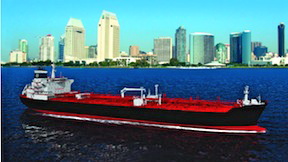
General Dynamics NASSCO has started work on three 50,000-ton oil tankers that will be used by SEA-Vista for shipment between U.S. ports. SEA-Vista is a joint venture between Seacor Holdings Inc. and Avista Capital Partners.
Debora Denning, wife of Seacor Vice President of Engineering Tom Denning, signaled the beginning of construction by pressing a button to cut the first piece of steel in NASSCO’s shipyard near Barrio Logan.
These new 610-foot-long vessels will incorporate the latest environmental protection features. They can be converted to carry liquified natural gas instead of oil.
The new tankers come at a time when U.S. production of oil and natural gas is surging due to the new technique of hydraulic fracturing, or fracking. In September NASSCO started work on a fleet of five tankers for American Petroleum Tankers. — Times of San Diego
National Park Service Wants to Triple
Entrance Fee at Cabrillo National Monument
The National Park Service is scheduled to hold a meeting this afternoon to take public input on proposed entrance fee hikes at the Cabrillo National Monument at the tip of Point Loma. The NPS proposals include tripling the cost for vehicles from the current $5 to $15, beginning next summer.
Bicyclists and pedestrians, who now pay $3, would have to pay $7. The cost for motorcycles would rise from $5 to $10. Also, the park service plans to increase the price of annual passes from $15 to $30.
The increases would be the first since entrance fees were first collected 27 years ago, according to the NPS.
Park officials said 80 percent of the fees collected at the park are used locally to preserve natural and cultural resources, improve visitor facilities and provide educational and recreational opportunities for the public.
Future projects include restoration of the damaged bayside trail, upgraded informational displays about bunkers dating back to World Wars I and II, and production of a new film about Juan Rodriguez Cabrillo, the first European to arrive in San Diego.
The meeting is set for 4 p.m. at the monument. For those who are interested by can’t attend, comments can be submitted online at http://parkplanning.nps.gov/cabr, or mailed to the Park Superintendent, 1800 Cabrillo Memorial Drive, San Diego, CA, 92106.
— Times of San Diego
Personnel Matters
Jason Evans Elected to Bar Association Group
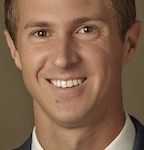
Jason Evans, an associate attorney with San Diego-based CaseyGerry, has been elected vice chair of the San Diego County Bar Association’s Forum for Emerging Lawyers, representing thousands of young lawyers throughout San Diego.
Evans will serve a one-year term as 2015 vice chair, followed by the 2016 chair appointment. In both capacities, he will concentrate on leading San Diego’s emerging lawyers through education, events and community outreach.
Evans, who joined Casey Gerry in 2012, is a member of the firm’s complex litigation team, focusing on consumer class actions, product liability and serious personal injury litigation.
He previously worked for the San Diego Volunteer Lawyers Program representing victims of domestic and elder abuse and served as a legal assistant for Spach, Capaldi and Waggaman LLP in Newport Beach.
Torrey Pines Bank Hires VP, Senior Loan Officer
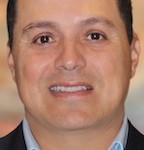
Torrey Pines Bank has hired Rick Martinez as vice president, senior loan Officer at its Carmel Valley branch. Martinez brings two decades of business expertise and experience in the commercial banking and finance industries. He will work closely with business owners and executives at small and medium sized companies to offer financing and deposit solutions to improve cash flow and provide expansion options.
Prior to joining Torrey Pines Bank he was vice president, business banking for a San Diego-area business bank. He is a former director of the Doctors Advisory Council and a past board chair of North County Health Services. He has a bachelor’s degree in business administration from San Diego State University.
Padres Name Director of Scouting
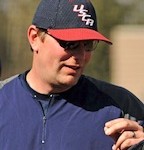
The San Diego Padres announced they have named Mark Conner director of scouting, promoting him from his position as regional supervisor. Conner, 38, first joined the Padres as an amateur scout in 2010 and was promoted to northeast regional supervisor prior to the 2014 season. After his first season with the organization, he was honored with the Denny Galehouse Scout of the Year Award.
Before joining the Padres, Conner served as pitching coach at the University of South Carolina for five seasons (2005-09).
As a player at Cumberland University in Tennessee, Conner was a catcher, earning Mid-South All-Conference honors in 1998.

‘Tooth Fairy’ Brings Insight to
San Diego Autism Researchers
Like most children, autistic kids hate having their blood drawn. And parents don’t want to put them through unnecessary invasive procedures.
That’s why UC San Diego autism researcher Alysson Muotri studies genetic material that doesn’t need to be extracted at all.
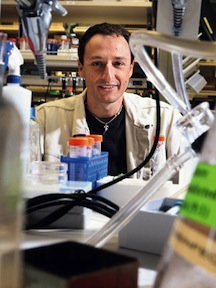
“We isolate the cells from the tooth,” said Muotri. Through a program called the Tooth Fairy Project, he has convinced parents to send him their kids’ baby teeth after they’ve fallen out. “It’s completely non-invasive and it’s an easy way to engage the families to participate in the science.”
For a study published Tuesday in Molecular Psychiatry, Muotri and his colleagues extracted cells from the teeth of about 300 children. Then they reprogrammed tooth cells into brain cells using stem cell techniques.
When they put the brain cells derived from the teeth of autistic children under the microscope, they saw the hallmarks of autism: neurons of different sizes and shapes, and connection problems between brain cells.
But the genetics behind these physiological markers remain a mystery in many cases.
To try to find mutations that could be leading to autism, Muotri sequenced the genomes of his research subjects. He was able to pinpoint a specific mutation underpinning one patient’s brain features.
Muotri said, “Because we knew the gene, we were able to find one drug, called hyperforin.” It’s a compound that regulates the gene they’d identified. When they experimented with hyperforin on lab-grown neurons, the researchers saw promising results.
“By treating the neurons with this drug, we were able to revert them so they behaved like normal neurons,” Muotri said.
Muotri admits this particular genetic mutation is probably not common among people with autism. But he says continuing to carry out studies like this can help personalize the understanding of autism down to each individual patient, and ultimately could help guide the search for broad autism therapies.
— KPBS



